In physics, attenuation is the gradual loss of flux intensity through a medium. For instance, dark glasses attenuate sunlight, lead attenuates X-rays, and water and air attenuate both light and sound at variable attenuation rates.
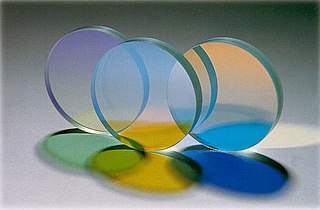
In the field of optics, transparency is the physical property of allowing light to pass through the material without appreciable scattering of light. On a macroscopic scale, the photons can be said to follow Snell's law. Translucency allows light to pass through, but does not necessarily follow Snell's law; the photons can be scattered at either of the two interfaces, or internally, where there is a change in index of refraction. In other words, a translucent material is made up of components with different indices of refraction. A transparent material is made up of components with a uniform index of refraction. Transparent materials appear clear, with the overall appearance of one color, or any combination leading up to a brilliant spectrum of every color. The opposite property of translucency is opacity. Other categories of visual appearance, related to the perception of regular or diffuse reflection and transmission of light, have been organized under the concept of cesia in an order system with three variables, including transparency, translucency and opacity among the involved aspects.

Reflection is the change in direction of a wavefront at an interface between two different media so that the wavefront returns into the medium from which it originated. Common examples include the reflection of light, sound and water waves. The law of reflection says that for specular reflection the angle at which the wave is incident on the surface equals the angle at which it is reflected.
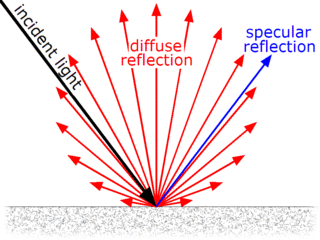
Diffuse reflection is the reflection of light or other waves or particles from a surface such that a ray incident on the surface is scattered at many angles rather than at just one angle as in the case of specular reflection. An ideal diffuse reflecting surface is said to exhibit Lambertian reflection, meaning that there is equal luminance when viewed from all directions lying in the half-space adjacent to the surface.

Specular reflection, or regular reflection, is the mirror-like reflection of waves, such as light, from a surface.

Lambertian reflectance is the property that defines an ideal "matte" or diffusely reflecting surface. The apparent brightness of a Lambertian surface to an observer is the same regardless of the observer's angle of view. More precisely, the reflected radiant intensity obeys Lambert's cosine law, which makes the reflected radiance the same in all directions. Lambertian reflectance is named after Johann Heinrich Lambert, who introduced the concept of perfect diffusion in his 1760 book Photometria.

In physics, backscatter is the reflection of waves, particles, or signals back to the direction from which they came. It is usually a diffuse reflection due to scattering, as opposed to specular reflection as from a mirror, although specular backscattering can occur at normal incidence with a surface. Backscattering has important applications in astronomy, photography, and medical ultrasonography. The opposite effect is forward scatter, e.g. when a translucent material like a cloud diffuses sunlight, giving soft light.
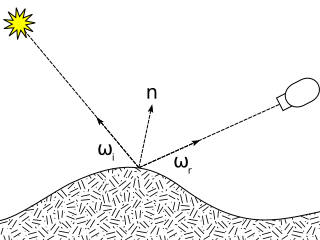
The bidirectional reflectance distribution function (BRDF), symbol , is a function of four real variables that defines how light is reflected at an opaque surface. It is employed in the optics of real-world light, in computer graphics algorithms, and in computer vision algorithms. The function takes an incoming light direction, , and outgoing direction, , and returns the ratio of reflected radiance exiting along to the irradiance incident on the surface from direction . Each direction is itself parameterized by azimuth angle and zenith angle , therefore the BRDF as a whole is a function of 4 variables. The BRDF has units sr−1, with steradians (sr) being a unit of solid angle.
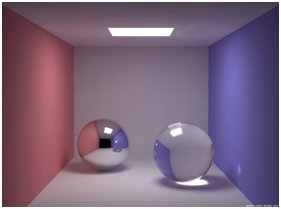
Gloss is an optical property which indicates how well a surface reflects light in a specular (mirror-like) direction. It is one of the important parameters that are used to describe the visual appearance of an object. Other categories of visual appearance related to the perception of regular or diffuse reflection and transmission of light have been organized under the concept of cesia in an order system with three variables, including gloss among the involved aspects. The factors that affect gloss are the refractive index of the material, the angle of incident light and the surface topography.

Opacity is the measure of impenetrability to electromagnetic or other kinds of radiation, especially visible light. In radiative transfer, it describes the absorption and scattering of radiation in a medium, such as a plasma, dielectric, shielding material, glass, etc. An opaque object is neither transparent nor translucent. When light strikes an interface between two substances, in general some may be reflected, some absorbed, some scattered, and the rest transmitted. Reflection can be diffuse, for example light reflecting off a white wall, or specular, for example light reflecting off a mirror. An opaque substance transmits no light, and therefore reflects, scatters, or absorbs all of it. Other categories of visual appearance, related to the perception of regular or diffuse reflection and transmission of light, have been organized under the concept of cesia in an order system with three variables, including opacity, transparency and translucency among the involved aspects. Both mirrors and carbon black are opaque. Opacity depends on the frequency of the light being considered. For instance, some kinds of glass, while transparent in the visual range, are largely opaque to ultraviolet light. More extreme frequency-dependence is visible in the absorption lines of cold gases. Opacity can be quantified in many ways; for example, see the article mathematical descriptions of opacity.

Neutron reflectometry is a neutron diffraction technique for measuring the structure of thin films, similar to the often complementary techniques of X-ray reflectivity and ellipsometry. The technique provides valuable information over a wide variety of scientific and technological applications including chemical aggregation, polymer and surfactant adsorption, structure of thin film magnetic systems, biological membranes, etc.

Underwater vision is the ability to see objects underwater, and this is significantly affected by several factors. Underwater, objects are less visible because of lower levels of natural illumination caused by rapid attenuation of light with distance passed through the water. They are also blurred by scattering of light between the object and the viewer, also resulting in lower contrast. These effects vary with wavelength of the light, and color and turbidity of the water. The vertebrate eye is usually either optimised for underwater vision or air vision, as is the case in the human eye. The visual acuity of the air-optimised eye is severely adversely affected by the difference in refractive index between air and water when immersed in direct contact. Provision of an airspace between the cornea and the water can compensate, but has the side effect of scale and distance distortion. The diver learns to compensate for these distortions. Artificial illumination is effective to improve illumination at short range.

An integrating sphere is an optical component consisting of a hollow spherical cavity with its interior covered with a diffuse white reflective coating, with small holes for entrance and exit ports. Its relevant property is a uniform scattering or diffusing effect. Light rays incident on any point on the inner surface are, by multiple scattering reflections, distributed equally to all other points. The effects of the original direction of light are minimized. An integrating sphere may be thought of as a diffuser which preserves power but destroys spatial information. It is typically used with some light source and a detector for optical power measurement. A similar device is the focusing or Coblentz sphere, which differs in that it has a mirror-like (specular) inner surface rather than a diffuse inner surface.

Sheen is a measure of the reflected light (glossiness) from a paint finish. Glossy and flat are typical extreme levels of glossiness of a finish. Gloss paint is shiny and reflects most light in the specular (mirror-like) direction, while on flat paints most of the light diffuses in a range of angles. The gloss level of paint can also affect its apparent colour.
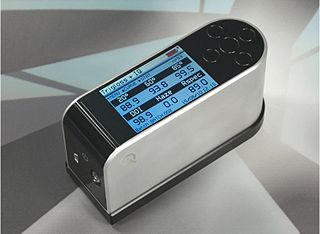
A glossmeter is an instrument which is used to measure specular reflection gloss of a surface. Gloss is determined by projecting a beam of light at a fixed intensity and angle onto a surface and measuring the amount of reflected light at an equal but opposite angle.
The visual appearance of objects is given by the way in which they reflect and transmit light. The color of objects is determined by the parts of the spectrum of light that are reflected or transmitted without being absorbed. Additional appearance attributes are based on the directional distribution of reflected (BRDF) or transmitted light (BTDF) described by attributes like glossy, shiny versus dull, matte, clear, turbid, distinct, etc. Since "visual appearance" is a general concept that includes also various other visual phenomena, such as color, visual texture, visual perception of shape, size, etc., the specific aspects related to how humans see different spatial distributions of light have been given the name cesia. It marks a difference with color, which could be defined as the sensation arising from different spectral compositions or distributions of light.
Picture framing glass usually refers to flat glass or acrylic ("plexi") used for framing artwork and for presenting art objects in a display box.
There are two different types of haze that can occur in materials:

The hiding power is an ability of a paint to hide the surface that the paint was applied to. Numerically, it is defined as an area of surface coated by a volume of paint at which the "complete hiding" of the underlying surface occurs.
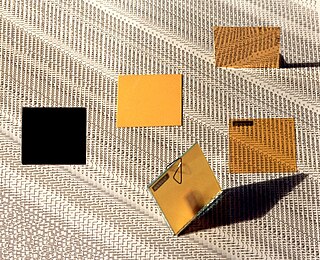
Cesia is the name given to visual appearances related to the perception of different spatial distributions of light. Light radiation that is not absorbed by an object can be reflected or transmitted either diffusely or regularly. These interactions of light with matter are perceived with a greater or lesser degree of gloss, more or less transparent, translucent or opaque, at different levels of darkness.

![Distinctness of Image (DOI) Low DOI is caused by "large" surface structures distorting the reflected light. The surface is visible- orange peel.
D
O
I
[?]
d
R
/
d
Th
{\displaystyle DOI\varpropto dR/d\Theta }
D
O
I
[?]
D
R
e
f
l
e
c
t
a
n
c
e
D
A
n
g
l
e
{\displaystyle DOI\propto {\frac {\Delta Reflectance}{\Delta Angle}}}
Reflected image Quality (RIQ)
RIQ is a more sensitive, updated version of DOI A new high sensitivity/high resolution sensor allows improved measurement.
RIQ is a more sensitive, updated version of DOI
D
O
I
[?]
d
R
/
d
Th
{\displaystyle DOI\varpropto dR/d\Theta }
H
a
z
e
[?]
D
R
e
f
l
e
c
t
a
n
c
e
D
A
n
g
l
e
{\displaystyle Haze\propto {\frac {\Delta Reflectance}{\Delta Angle}}}
A new high sensitivity/high resolution sensor allows improved measurement. DOI Example.png](http://upload.wikimedia.org/wikipedia/commons/9/94/DOI_Example.png)




















